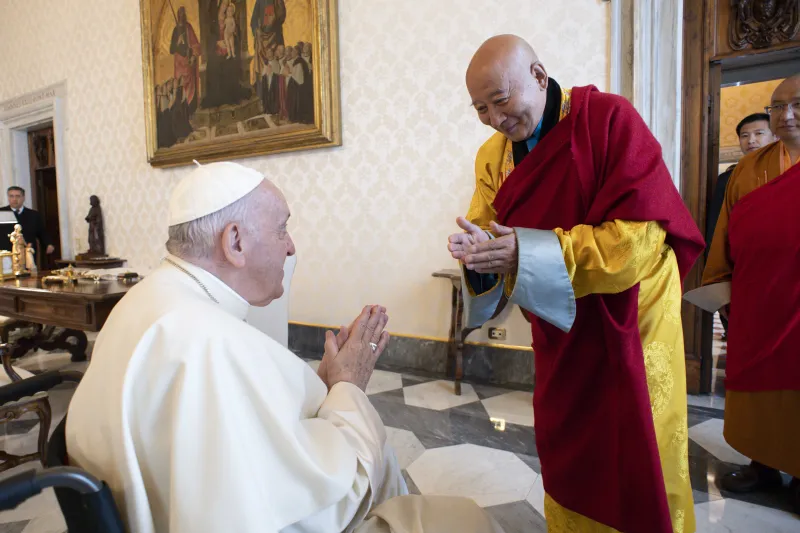
Vatican City, May 28, 2022 / 07:10 am (CNA).
Pope Francis invited Catholics and Buddhists to work together for peace and nonviolence, during a Vatican meeting with Buddhist leaders from Mongolia on Saturday.
“Peace is the ardent yearning of humanity today. Therefore, through dialogue at all levels, it is urgent to promote a culture of peace and nonviolence and to work for it,” the pope said on May 28, speaking from a wheelchair in his study.
“This dialogue must call on everyone to reject violence in all its forms, including violence against the environment,” he stated. “Unfortunately, there are those who continue to abuse religion by using it to justify acts of violence and hatred.”
The leaders of Mongolian Buddhism met with Pope Francis in the Vatican’s apostolic palace, together with Bishop Giorgio Marengo, apostolic prefect of Ulaanbaatar, Mongolia. Cardinal Miguel Ayuso Giuxot, president of the Pontifical Council for Interreligious Dialogue was also present.
The Mongolian Buddhist authorities are in Rome to mark the 30th anniversary of the presence of the Catholic Church in Mongolia and the 30th anniversary of diplomatic relations between the East Asian country and the Holy See.
In Mongolia, around 53% of the population is Buddhist. There are an estimated 1,300 Catholics out of a total population of 3.2 million.
The visit of the Mongolian Buddhist delegation to the Vatican “is intended to deepen your friendly relations with the Catholic Church, to promote mutual understanding and cooperation in order to build a peaceful society,” Pope Francis noted.
He noted that both Jesus and Buddha were peacemakers, and said, “in a world ravaged by conflict and war, as religious leaders, deeply rooted in our respective religious doctrines, we have a duty to arouse in humanity the will to renounce violence and build a culture of peace.”
Despite the small number of Catholics in Mongolia, “the Church is fully committed to promoting a culture of encounter, following her Master and Founder who said, ‘Love one another as I have loved you,’” Pope Francis said.
“Let us strengthen our friendship for the good of all,” he urged. “Mongolia has a long tradition of peaceful coexistence of different religions. My hope is that this ancient history of harmony in diversity can continue today through the effective implementation of religious freedom and the promotion of joint initiatives for the common good.”
“Your presence here today is in itself a sign of hope. With these sentiments, I invite you to continue your fraternal dialogue and good relations with the Catholic Church in your country, for the cause of peace and harmony,” he stated.
If you value the news and views Catholic World Report provides, please consider donating to support our efforts. Your contribution will help us continue to make CWR available to all readers worldwide for free, without a subscription. Thank you for your generosity!
Click here for more information on donating to CWR. Click here to sign up for our newsletter.




“Peace is the tranquility of order,” which begins with proper worship of God. This trope, “Jesus was a peacemaker” is nonsense, when Our Lord said specifically that he came to bring a sword—and that even families would be divided over belief in him as Saviour.
Working together for peace is a mission second to none. Peace and non-violence are powerful tools of mass construction.